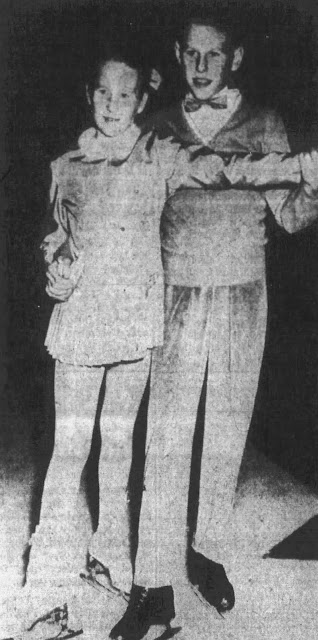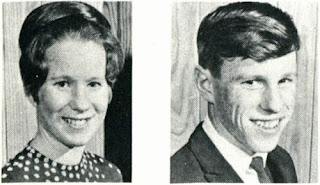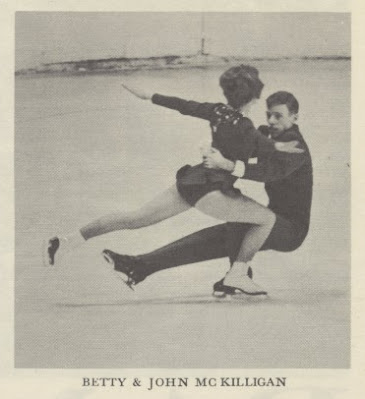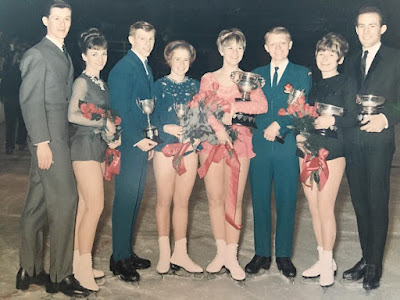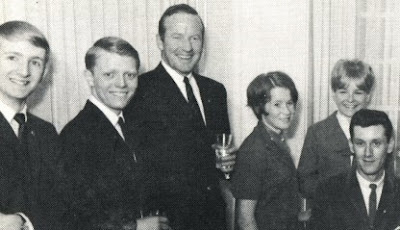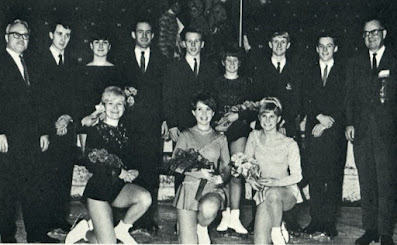Photo courtesy Toronto Public Library, from Toronto Star Photographic Archive. Reproduced for educational purposes under license permission.
Betty and John McKilligan were born just over a year apart - he on August 28, 1948 and she on November 16, 1949 - in Victoria, British Columbia. Their Manitoba born father Art, who served as a pilot with the Royal Canadian Air Force during World War II, worked in automotive services management, and later as a teacher and Vice-Principal of British Columbia Institute of Technology's Pacific Vocational Institute. Their mother Dorothy was a former dancer who was born in England.
Betty and John and their younger brothers Patrick and Andrew grew up in the Victoria suburb of Garden Head. Their path to the figure skating world was far from conventional. Their father, a former player on the Trail Smoke Eaters hockey team, would regularly pick up local children and take them to skate once a week at the Memorial Arena - Victoria's only rink at the time. It had a domed roof, with a concrete ceiling stuffed with straw and hay. When John was eight, he acted the mascot for an all-stars hockey team his father coached. He later took up pee-wee and midget hockey.
It wasn't until the family moved to Nanaimo (when Betty and John were twelve and thirteen) that any talk of figure skating came up. A new coach at the Nanaimo Figure Skating Club, Yvette Killeen, came to the family home to talk to their parents about lessons for Betty. At the time, Betty, John and their brothers were playing baseball with a whistle ball in the backyard. Betty and John got into a tiff and he picked her up and spun her over his head a few times before throwing her to the ground. Their parents were horrified, but Yvette's reaction was, "Oh! He's so strong! They should do pairs skating!" The transition from hockey to figure skating wasn't an easy one for John. He fell so many times that he ended up with swollen knees. Out of frustration, he had the toe picks taken off his skates.
In 1963 - their very first year skating together - Betty and John won the junior pairs title at the British Columbia's Pacific Coast Championships in West Vancouver. On the ferry ride over, their father bought a copy of "The Province". There was a front page story about Faye Strutt and Jimmy Watters, a British Columbian pair who had placed third in the Olympic Trials in Toronto, stamping their ticket for the 1964 Winter Olympic Games in Innsbruck. Betty and John decided then and there that their goal was to finish third four years later and go to the 1968 Winter Olympic Games in Grenoble.
After finishing third in junior pairs at their first Canadian Championships in 1964, Betty and John won the national junior title in 1965. A challenge that they faced in taking their skating to the next level was the lack of pairs coaches in British Columbia at the time. Aside from Faye Strutt and Jimmy Watters' coach Dr. Hellmut May and another coach in Summerland, few professionals on the West Coast specialized in pairs at that point in time. Their father would film the pairs acts in the Ice Capades shows and Betty and John got their first real lessons in lifting from one of the pairs they were able to meet backstage. "In the summer of '65, we went to California and learned from Barbara Wagner, the four-time World Champion and Olympic Champion. She was awesome," recalled John. "When we went down there it was in a studio-style arena - so no boards - which was really weird for us. The first day down there she says, 'I'm going to sit here and you can show me everything you can do' and then she said, 'Okay, now I've got to teach you how to skate.' For the first month, both of us did nothing but stroking and skating exercises. Every free skating session, I would have a seven foot long stick stuck down my back tied with belts to hold it in place and then I had another go through my sleeves. If ever I was bent forward, any of the kids on the ice were allowed to hit the stick. We didn't realize until we got home after two months and skated at the North Shore Winter Club how much our speed and power had improved."
In 1966, Betty and John passed their Gold Pair Test and took their first crack at the senior pairs title at the Canadian Championships, finishing third. It was the first year they had the short program (then known as the compulsory connected program) at the Canadian Championships and there was a big push at the time for pairs to improve their singles skating to be able to do some of the new required elements. John remembered, "When we got into pairs skating, typically pairs were formed by putting two failing single skaters together (also for dance pairs) - which meant that single jump skills were weak compared to single skaters... It was way more important to not make mistakes than to increase solo content. For this reason, we only did jumps that we were very confident we would complete... One of the compulsory elements [at the 1966 Canadians] was a pairs sit spin. We got penalized because they said my sister wasn't low enough in the spin. I still remember Barbara [Wagner] out in the middle of the dance floor grabbing Norrie Bowden and going, 'Okay, tell me when I'm low enough! Tell me when I'm low enough!' That was a riot."
Photos courtesy "Skating" magazine
Betty and John trained with Barbara Wagner again during the summer of 1966 and showed up at the 1967 Canadian Championships ready to show off the progress they'd made in their skating. Their younger brother Patrick won the novice men's event, and seventeen and eighteen year old Betty and John seemed poised to win their first national title. Patrick told a Canadian Press reporter, "Betty and John can do it. After all, they're McKilligan's and this championship is our centennial project." Disaster struck in the duo's first practice session. "We were doing this one-armed side lift where Betty would scissor her feet. She scissored so hard that the back of her left blade went through the tongue of her right boot and severed the tendon to her second toe," remembered John. "We went to emergency, the surgeon there wanted to operate - open up her foot and stitch the tendon back together. When my sister refused, he wanted to phone and talk to my parents. Funny thing was, my mother (who has always been psychic) woke up in bed in Vancouver at precisely the same time my sister stabbed herself in the foot. Our practice was about 8 AM in Toronto, so 5 AM in Vancouver. My mother sat bolt upright in bed and... sat at the kitchen table and made herself tea waiting for the phone to ring. As soon as the doctor phoned, she knew something was wrong. The doctor said that if he didn't fix that tendon, she'd never be able to lift that toe. My sister said 'I'll give up my toe to skate.'" Betty showed up to compete with a pronounced limp, in serious pain. They soldiered through both programs and, despite nearly falling on an overhead lift and some shaky side-by-side jumps, managed to outskate 1966 Silver Medallists Alexis and Chris Shields and 1966 Junior Champions Anna Forder and Richard Stephens to win their first Canadian senior pairs title. Betty told reporters, "It wasn't our best performance. We've skated better before but we were good enough to win it anyway."
Betty and John McKilligan (third and fourth from left) with the 1967 Canadian World Team. Photo courtesy Valerie Jones Bartlett.
Betty and John's win at the 1967 Canadian Championships earned them the right to represent their country at both the North American and World Championships. They placed fifth out of six teams at the North Americans in Montreal, again defeating the Shields', but placed a disappointing eighteenth out of nineteen pairs at their first World Championships that year in Vienna. Not only was Betty still suffering from the severed tendon in her landing foot, but the duo were skating on outdoor ice for the first time in competition. The weather during the compulsory connected program was abysmal, with torrential rain and soft ice making conditions at times treacherous. The 1967 World Championships would be the last ISU Championship held entirely on an open-air rink.
Jay Humphry, Donald Knight, Betty McKilligan, Joni Graham and John Bailey with a representative of the Canadian government at the 1967 World Championships in Vienna. Photo courtesy "Skating" magazine.
In the lead-up to the Olympic season in 1968, Betty and John trained with World Champion Jean Westwood at the Hollyburn Country Club. With Jean, they refined their style and added some exciting new moves to their repertoire: the throw Axel, a 'jump camel spin' where John jumped over Betty, the Cat Swing - a twist-like lift/throw where Betty did an Axel over John's head after he boosted her in the air, and a series where they began a death spiral, he separated and performed a solo Axel, then returned directly to a death spiral. In practice, he could do a double Axel, but they left that out because it was inconsistent and the reward wasn't worth the risk.
At the 1968 Canadian Championships in Vancouver, Betty and John defended their national title, despite an unfortunate fall on a throw Axel jump. John reminisced, "That year in Vancouver was just a hoot. Our brother won junior men and B.C. skaters won all four senior titles - Karen Magnussen, Joni Graham and Don Phillips in dance and Jay Humphry, who was from B.C. but was training in Toronto. The big news was that was the year that Toller emerged, and so all the skaters were just going nuts and the judges, they just lambasted him... Because it was [in British Columbia], we had huge pressure on us, because only two pairs got to go the Olympics and one got to go to Worlds. Canada had been super strong with pairs. You had Norrie Bowden and Frances Dafoe, Barbara Wagner and Bob Paul, The Jelinek's and Debbi Wilkes and Guy Revell. Those pairs so dominated, so that there wasn't the big build up of pairs under them. We went from being in our very first ever competition in 1963 to Canadian Champions in '67. There were two reasons - we did a lot and there wasn't much competition either."
Betty and John's Olympic experience was an eventful one. With little television coverage of the Games in those days, they really didn't have much idea what to expect when they got to Grenoble. John remembered, "We were not the very respectable teams we have now... When we marched into the opening stadium in Grenoble, some of the other teams had been given strict instructions on what to do. None of the Canadians had, so when something happened on the eastern side of the stadium, we all flocked that way and when something happened on the western side, we all flocked that way. Our chef de mission ended up getting an ear full about that to start with. The village consisted of two highrises - one for men and another for women. The women's had French soldiers with machine guns on guard at the front door and the men's were wide open, so anyone could come and go."
That freedom to come and go as they pleased led to quite a few shenanigans. Several skaters on the team were involved in scalping extra tickets and midnight missions to cut down and steal Olympic and Canadian flags that been hoisted in various venues around Grenoble. These late-night runs were more often than not successful, until John got caught red-handed by the local police and hauled into the station. It was Linda Carbonetto's charming manner, quick-thinking and French that got him out of a sticky situation. "Ellen Burka's mother was a professor at the University of Grenoble - of all the places in the world, but she was. She held a party for us about two nights before the Closing Ceremonies. The subject of these flags came up at the party and Doug Peckinpaugh, who was the figure skater chef de mission, came over to give us shit but he was basically just doing it so Grandma would hear. We boys in our brilliance went 'Hmm... why is he upset? I bet he's upset because we didn't get him one.'"
Both Betty and John and the other Canadian pair in Grenoble, Anna Forder and Richard Stephens, had a disappointing showing. Doomed by drawing early spots in the starting order for the free skate, both pairs skated more or less clean but finished sixteenth and seventeenth... well behind the winners Ludmila and Oleg Protopopov. Betty and John admired Ludmila and Oleg. John remembered, "They were very friendly. During one of our very first practices, we had this footwork where our arms went up and down and we slapped our legs. Right after the practice, we went into the change room and the Protopopov's were getting ready to go out to practice. Oleg just went and slapped his arms and his legs and burst out laughing. In my first semester of University at SFU, I took Russian, so I knew just enough to be able to say a couple of words."
Betty and John McKilligan (back row, fourth and fifth from right) with George J. Blundun, Doug Peckinpaugh and the 1968 Canadian World Team. Photo courtesy "Skating" magazine.
After the Olympics, Betty and John competed in their final World Championships in Geneva, moving up from fifteenth place in the compulsory connected program to thirteenth overall with a good effort in the free skate. Afterwards, they made the difficult decision not to go on for another four years and end their skating partnership. John received several offers to partner both Canadian and American skaters, but turned them all down out of his consideration for his sister. John studied physical chemistry at Simon Fraser University, graduating with a double honours degree before embarking on a four-year adventure down under teaching at a new rink in Melbourne, Australia opened by Pat Burley. He did a little performing on Pat's portable twenty by twenty tank ice rink in a couple of nightclubs. Betty entered the B.C. Institute Of Technology and studied medical lab technology. She went to Montreal, worked in the Jewish Hospital and made really good friends with members of the Canadiens hockey team. She traveled around with them for a time, before becoming a national tester for medical labs.
Though their names may not be instantly recognizable to younger generations, Betty and John McKilligan were one of the most sensational Canadian pairs of the swinging sixties. Their legacy as the first pairs team from British Columbia to win a senior national title lives on today.
Skate Guard is a blog dedicated to preserving the rich, colourful and fascinating history of figure skating. Over ten years, the blog has featured over a thousand free articles covering all aspects of the sport's history, as well as four compelling in-depth features. To read the latest articles, follow the blog on Facebook, Twitter, Pinterest and YouTube. If you enjoy Skate Guard, please show your support for this archive by ordering a copy of figure skating reference books "The Almanac of Canadian Figure Skating", "Technical Merit: A History of Figure Skating Jumps" and "A Bibliography of Figure Skating": https://skateguard1.blogspot.com/p/buy-book.html.



